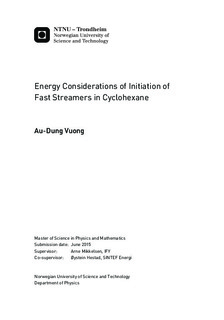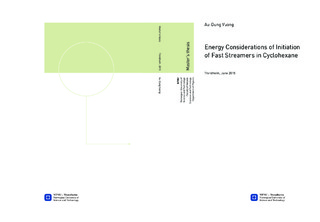| dc.description.abstract | The purpose of this study is to improve a model of streamer propagation in dielectric liquid by Hestad et al. at Sintef Energy Research, by considering the energy in an initiated second mode streamer. This is important, as more knowledge of the processes that cause discharges in liquid, may increase the lifetime expectancy of insulator liquids.
In the model a needle-gap configuration was considered, where the electrode tip was modeled as a rotational hyperboloid and he dielectric liquid was cyclohexane. When a voltage was applied, a thin channel was ionized and made con- ducting by the strong electric field. The energy difference after the electric field redistributes, was calculated in the finite element analysis software Comsol. It was assumed that the available energy will heat, evaporate, decompose and ionize cyclohexane. Kinetic Monte Carlo simulation were done to predict what cyclo- hexane decomposes to.
The initial streamer had the radius cr = 0.1 μm and the length cl = 8 μm. It consisted gas with the temperature T = 1485 K, where parts of it were ionized. Due to the temperature rise, the radius expanded to cr−exp = 24 μm. The tempera- ture in the streamer was too low to decompose cyclohexane. However the energy needed to decompose cyclohexane at T = 3000 K was only 1% of the vaporization energy. Therefore the decomposition will most likely happen as long as the temperature in the streamer is high enough. Compared to observations of second mode streamers, the temperature was too low and the radius was too big. | |

